To view previous releases, select one from the dropdown box:
Currently displaying information released on: March, 2024
BUSINESS OPENING AND CLOSING, DECEMBER 2023
Monthly (December 2023 vs November 2023, seasonally adjusted)
The number of active businesses in Nova Scotia declined 0.40% from November to December 2023 (going down to 20,579 active businesses).
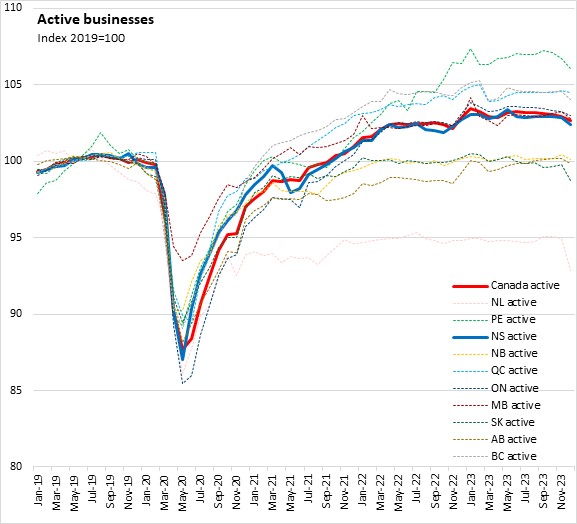
Nationally, active businesses were down by 0.24%. All provinces reported lower numbers of active businesses in December 2023 compared with November 2023. The largest declines were reported in Newfoundland and Labrador and Saskatchewan. The softest decline was in Quebec.

A business will be classified as 'opening' if it had no employment in the previous month and then has employment in the next month. A business is 'closing' if it had employment in the previous month and no employment in the current month. For opening and closing, the reason could be a permanent change (i.e. business exit) or temporary for reasons such as seasonal operations, capital maintenance or restructuring. Continuing business are those that had employment in both the current and previous month. Active businesses are the sum of continuing and opening business in the current month.
The rate at which business either opened, continued or closed can be examined to see how the number of active businesses has changed. The calculation for the opening, continuing and closure rates are based on the number of active businesses in the previous month.
Most businesses continue operating each month. In December 2023, Nova Scotia's business continuing rate was 95.6%, similar to the national average of 95.5%. Québec reported the highest business continuing rate (96.3%) while Newfoundland and Labrador (93.7%) reported the lowest.

Nova Scotia's business opening rate was 4.2% in December 2023 (4.5% nationally). Prince Edward Island had the highest business opening rate (5.1%) while Quebec had the lowest (3.6%).
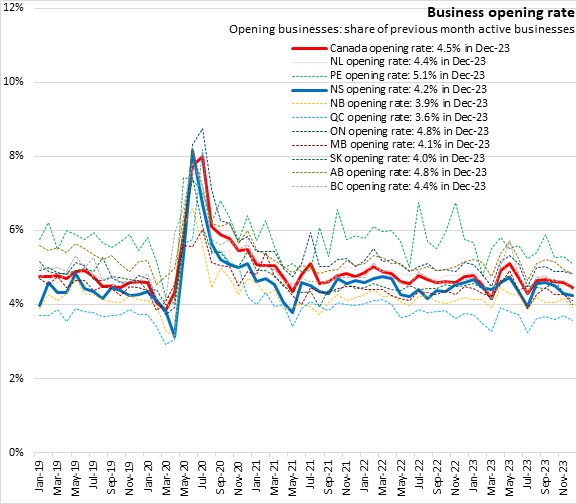
Nova Scotia's business closing rate was 4.6% in December 2023 (4.9% nationally). Newfoundland and Labrador reported the highest business closing rate (5.9%) while Québec had the lowest business closing rate (3.8%).

Year-over-year (December 2023 vs December 2022)
Compared with December 2022, the number of active businesses was down 0.31% for Nova Scotia. Nationally, active businesses were 0.18% lower than in December 2022. Two provinces reported a higher number of active businesses compared with December 2022, with the largest gain in Alberta. Newfoundland and Labrador and Saskatchewan reported the largest year-over-year declines in active businesses.
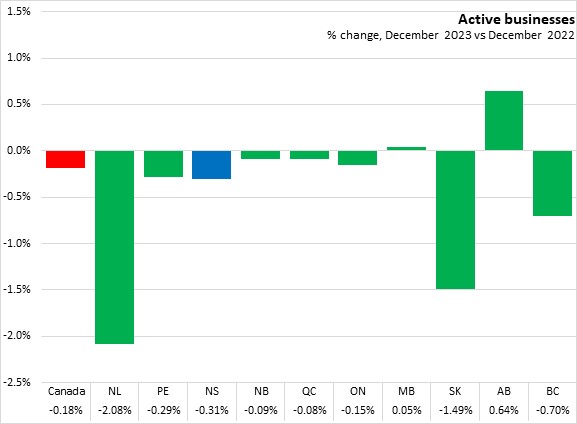
The number of active businesses in the Halifax and East Hants Census Metropolitan Area was up 0.7% from December 2022 to December 2023.
Out of 35 CMAs, 16 reported growth in active businesses over the past 12 months. Brantford and Windsor reported the largest rises in the number of active businesses while Regina and Peterborough reported the biggest declines.
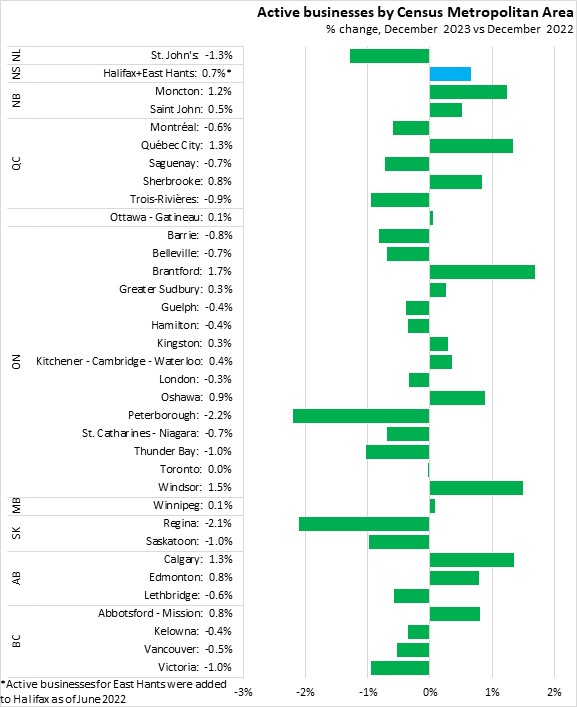
Compared with December 2022, the number of active Nova Scotia businesses in December 2023 was lower in most business sector industries, led by mining/oil/gas, retail, wholesale and finance/insurance/management. From December 2022 to December 2023, there were increases in the number of active businesses in utilities, construction, real estate/leasing, professional/technical services, and accommodation/food. Forestry/fishing active businesses were unchanged year-over-year.
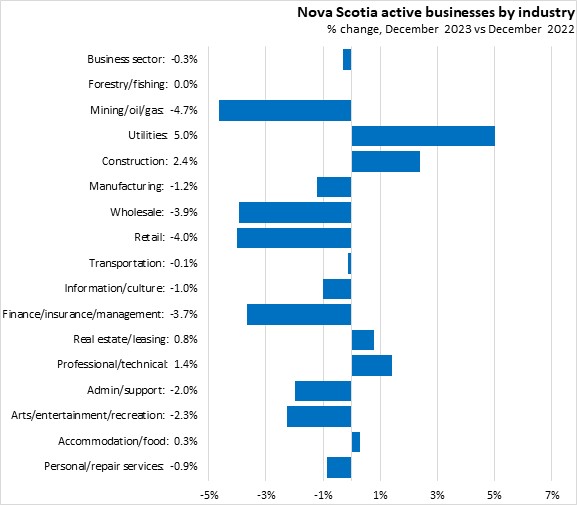
Nationally, the number of active businesses was down for all business sector industries except construction (unchanged), professional/technical (unchanged), utilities, arts/entertainment/recreation and accommodation/food.
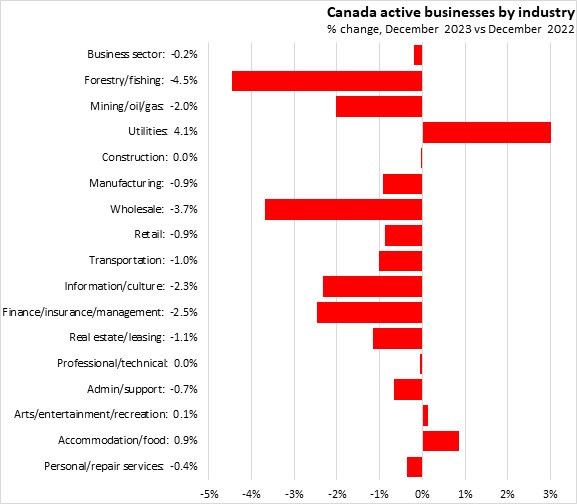
Statistics Canada has broken out specific data for tourism-related industries. Compared with December 2022, the number of active tourism-related businesses declined 0.3% in Nova Scotia as of December 2023, with declines in travel services, recreation/entertainment, and food/beverage, offsetting increases in accommodations and transportation.
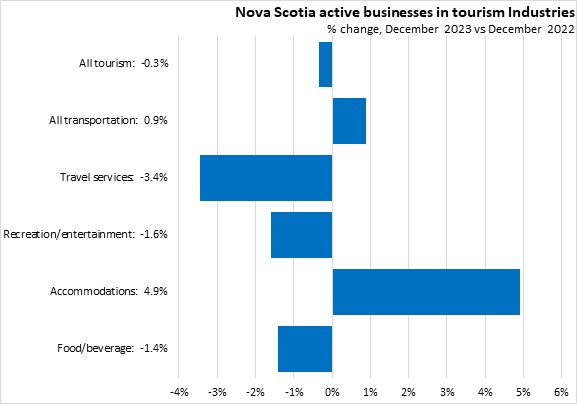
Nationally the number of tourism-related businesses increased 0.7% from December 2022 to December 2023. Growth in travel services, accommodations, food/beverage offset declines in transportation and arts/recreation/entertainment.

Trends
There has been a downward trend in forestry/business active businesses, while the decline in mining/quarrying has stabilized in the last year.
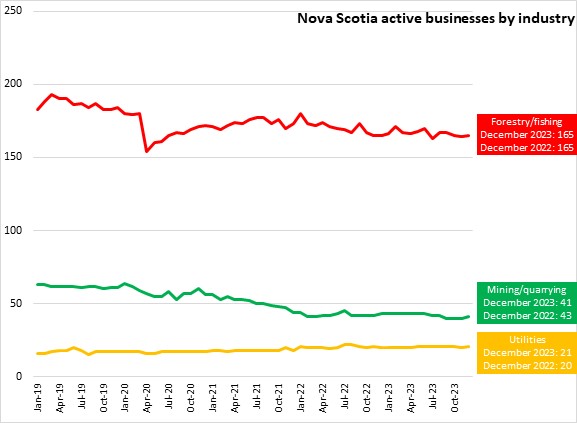
After steady growth after the pandemic, the number of construction businesses has plateaued. Manufacturing businesses have remained stable for the past 2 years.
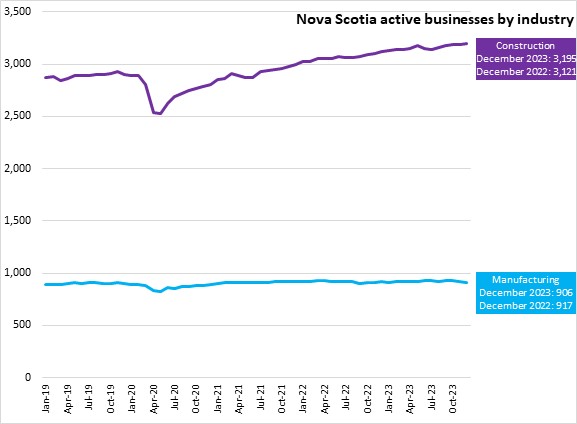
There have been recent declines in active personal/repair services and arts/recreation businesses.
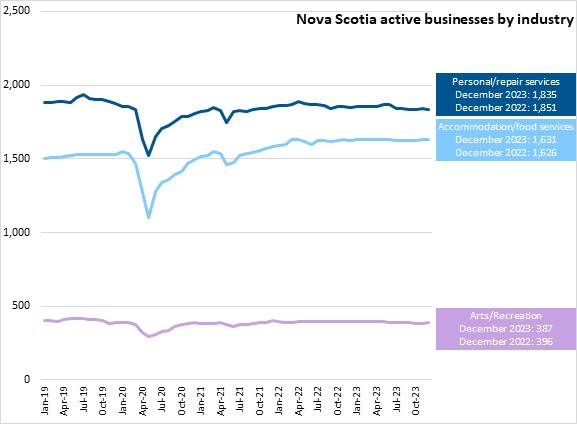
Retail and wholesale businesses have declined in recent months.

Real estate/leasing active businesses have stabilized after recent growth while administrative/support/call centre businesses have a recent decline. Transportation businesses have been trending down slightly over the last year.

There has been a recent decline in professional/technical services active businesses after steady gains in the last two years. Finance/insurance/management businesses have also trended down in recent months while the number of active businesses in information/culture has remained stable.

The source data is seasonally adjusted. The data may not aggregate due to firms being classified into multiple industry or geography.
Source: Statistics Canada. Table 33-10-0270-01 Experimental estimates for business openings and closures for Canada, provinces and territories, census metropolitan areas; Methodology: Business Opening and Closing RURAL HOUSING PROFILES, 2022
Statistics Canada released Rural Canada Housing Profiles (RCHP) data today for the 2022 reference year. It includes data on building permits, building investment, and information from the Canadian Housing Statistics Program and the 2021 Census of Population. All data are in current dollar values. The RCHP database defines rural and small town (RST) areas as communities outside census metropolitan areas and census agglomerations according to the Statistics Canada 2016 Standard Geographical Classification.
Building permits
Building permit values in rural areas of Nova Scotia were up 6.2% in 2022 to $622 million. Urban areas saw building permits increase at a faster rate in 2022, growing 23.6% to $1,441 million.
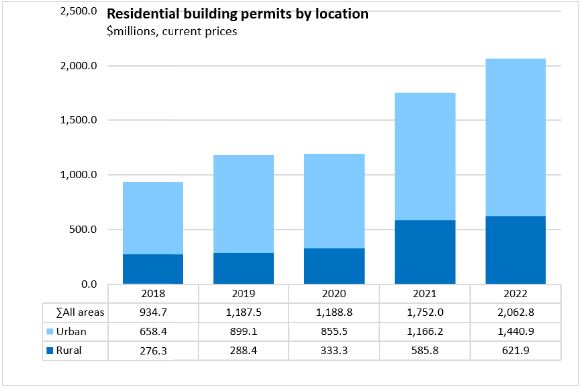
In rural areas of Nova Scotia, single unit dwellings make up the largest share of building permit values. Growth in building permits was primarily due to growth in singles, as well as growth in single - cottage permits. There was a decline in multiples - apartments in 2022 in rural areas of Nova Scotia.

In urban areas of Nova Scotia, multiples - apartments make up the largest share of permits, followed by singles and row houses.
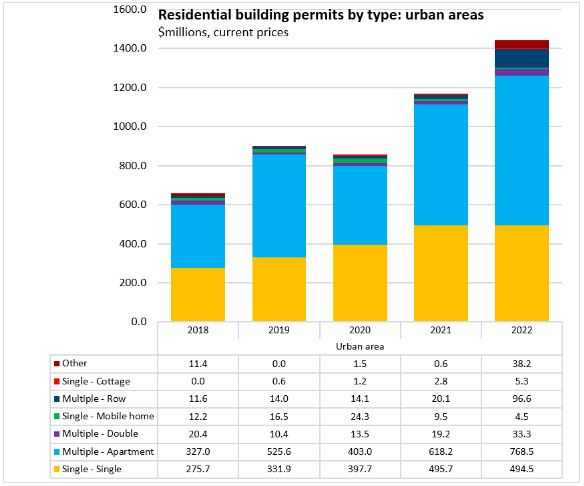
New construction makes up the largest share of building permits across all areas of Nova Scotia. In rural areas there is a larger share of alternations and improvements compared to urban areas.
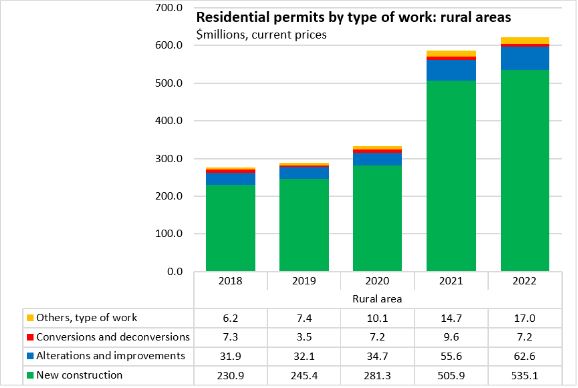 
Building investment
In 2022, rural housing investment increased 9.2% to 1,599.7 million. Urban housing investment increased by 29.5% in the same year to $3,024.9 million.

Single dwelling investment increased to $1,285.5 million and makes up the largest type of rural housing investment. In urban areas of Nova Scotia, single dwelling units are still the largest category but comparable in magnitude to investment in multiples.
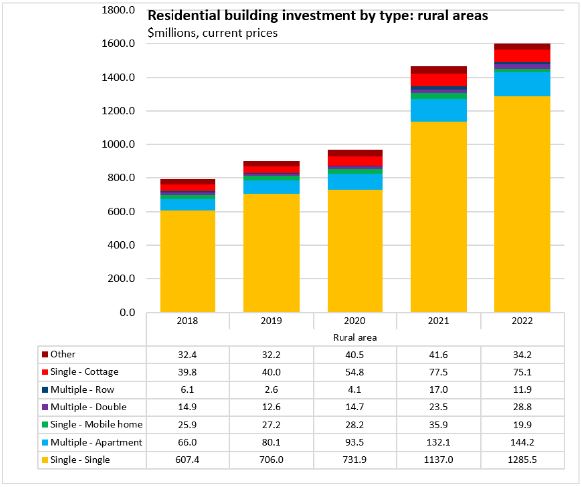 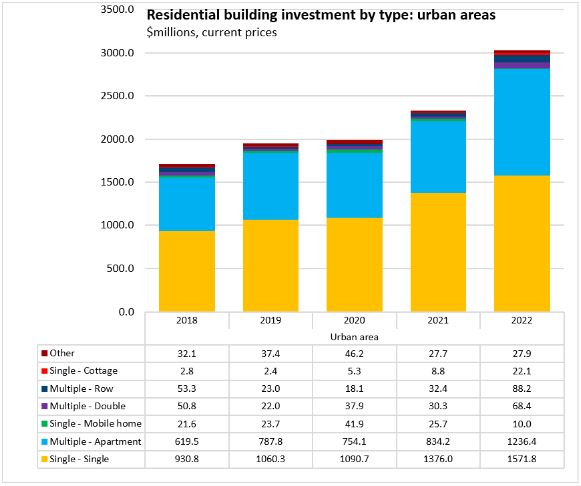
Building investment in alterations and improvements makes up the largest share of work in rural areas of Nova Scotia, followed by new construction. In urban areas of Nova Scotia, new construction overtook alterations and improvements as the largest investment category in 2022.
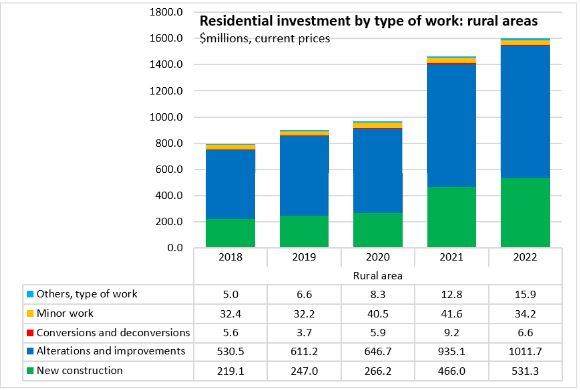 
Residential property values (2021)
Median property assessment in Nova Scotia was $134,000 in 2021. Median property assessments are typically higher in urban areas of Nova Scotia in 2021 compared to rural areas. Differences in assessment values partly reflect differences in composition of residential properties (i.e. cottages in rural areas typically have a lower value).

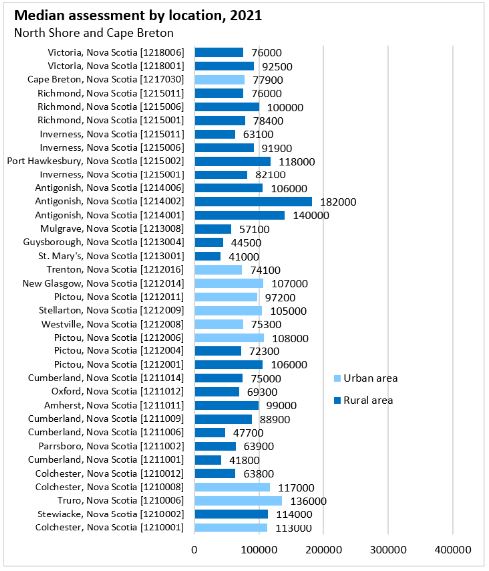
The median assessment per square foot in Nova Scotia (all areas) in 2021 was $117 per square foot.

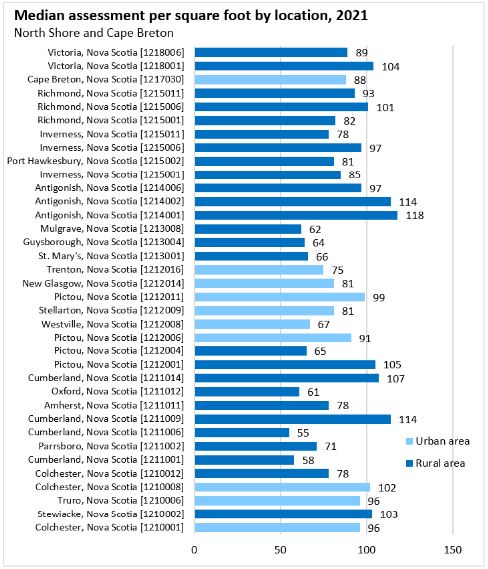
Source: Statistics Canada Table 46-10-0075-01 Rural Canada Housing Profiles, residential building permits, numbers and values, by type of residential building and type of work; Table 46-10-0076-01 Rural Canada Housing Profiles, values of investments in residential building construction, by type of residential building and type of work (x 1,000); Table 46-10-0077-01 Rural Canada Housing Profiles, residential property characteristics
|